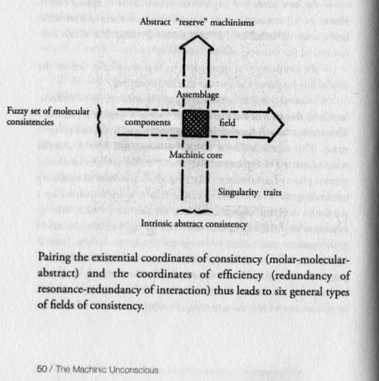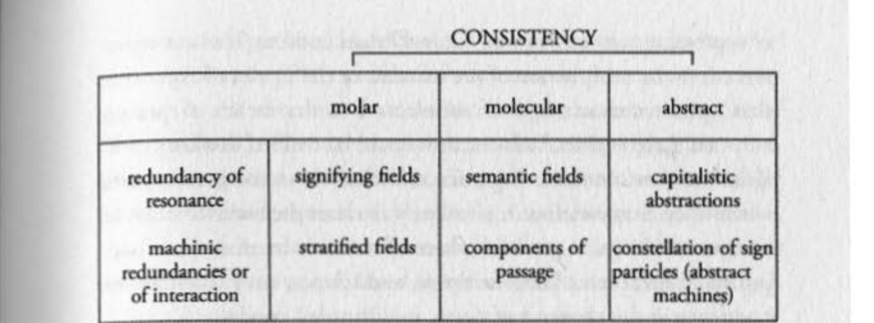Assemblages of Content and Expression Are Not Heaven-SentContent and expression are not attached to one another by virtue of the Holy Spirit. In the "beginning" of assemblages of enunciation, we find neither verb, nor subject, system, nor syntax ...; instead, there are components of semiotization, subjectification, conscientization, diagrammarism, and abstract machinisms. Whether on a synchronic or diachronic level, systems of correspondence and translation between states of language and states of culture are never self-evident. When they seem to partake in common sense it is because they have been treated in a way suitable for this purpose. Every mode of signification and semiotization must be related to its assemblages of enunciation. These assemblages depend on a degree of autonomy from the plane of content upon which they are inscribed and the readjustment of their angle of significance in relation to the local conditions of the semiological triangle, i.e. in the last analysis, their semiotic capacity of "holding'' a given subset of the world, setting in motion both the representation and the morphemes of the referent, all the while preserving their own functional cohesion within the framework of dominant syntaxes. Thus, the status of the subject does not rest upon a play of the signifier as structuralist psychoanalysis would have it; it is assembled by a set of heterogeneous components, the latter of which even semiotizes what l have called "dominant realities." The individuation of the process of enunciation and the process of semiotically discernibilizing oneself from another person are themselves inseparable from a certain mode of social organization. The split between the subject of enunciation and the subject of the statement is inseparable from the split between good and bad objects of the unconscious, in other words, the libidinal topics of the social field. The limit between the "received" ego, the semiologized ego, and the extracted ego is constantly manipulated by the socius.2 The disentanglement of the subject, the other, the law, and the plane of content always correspond to particular objects of power. Thus, content does not crystallize a universal world but a worldliness marked by contingent fields of force centralized around very precise systems of subjective resonance. Phallic redundancies, for example, do not concern a universal symbolic function but male dominance, authoritative institutions, and extremely particularized traits of repressive faciality. To bring the production of signification back to the concrete ground of micropolitics and matters of expression nevertheless does not assume that its access to deterritorialized systems is prohibited. It is not a question of extracting the assemblages of enunciation and the assemblages of desire on the side of the concrete and the "natural" in order to keep them safe from the abstract and the artificial! This is first of all because deterritorialized desire promotes capitalistic subjectification to a large extent (the ideal of a power essentially based upon semiological subjection and semiotic enslavement), but also because no "molecular revolution" could economize the implementation of deterritorialized assemblages of enunciation.' The contingent nature of enunciatory power formations does not at all imply that they "adhere" to the most material realities and abandon the most complex modes of semiotization. An assemblage draws its greater or lesser degree of freedom from the formula of its machinic nucleus, but this formula is basically metastable. As such, the abstract machines that compose it do not have any "real" existential consistency; they do not have any "mass," their own "energy," or memory. They are only infinitesimal indications hyper-deterritorialized from the crystallization of a possible between states of affairs and States of signs. We could compare them to the particles of contemporary physics that are "virtualized" by a theory that only preserves their identity for a negligible time; this identity is nevertheless unnecessary to concretely demonstrate since the theoretical-experimental complex can function in a satisfactory way by simply presupposing their existence. It is this metaphor which has led me to coin, in regards to the diagrammatic effect, the expression signs-particles: abstract machines "charge" themselves with redundancies of resonance (signification) or redundancies of interaction ("real" existence) depending on whether they are fixed and rendered powerless in a semiological substance or whether they inscribe themselves upon a machinic phylum. Until now, we have not focused on the criteria that would enable us to precisely define an assemblage in relation both to its components and the field in which it evolves. We will be able to clarify this question only on the condition that we better characterize: this concept of existential consistency. Indeed, the modalities of the existence of abstract machines are radically different from those of concrete assemblages. Existence as fundamental machinic coordinate concerns three general types of consistency: 1) Molar consistenciesHere redundant elements are strongly crystallized and stratified, allowing flows of redundancies to develop: 1. effects of weak resonance (signifying effect, e.g.: puce formal translation); 2. effects of weak interaction (surplus-value of stratified codes). Later we shall reconsider the fact that the molar/molecular opposition cannot be identified with a type of large/small or macro/micro spatial fitting but arises from an alternative of a micropolitical order, an alternative choice of consistency. {It exists, for example, in the microscopic refrains that follow molar or molecular politics independently of the fact that they function on the basis of redundancies of resonance or redundancies of interaction.) What characterizes the molar politics of stratification is the constitution of a world of stratified, identified, or hierarchized objects and subjects, singularities and abstract machines there being held by systems of coordinates that authorize only the minimum degree of freedom necessary for the survival of the assemblages. The exercise of what will later be defined as generative schizoanalysis will remain circumscribed in this low level of molar consistencies. It will consist in operating displacements of consistency within the assemblages, reducing the effects of resonance on behalf of weak diagrammatic interaction. 2) Molecular consistency Elements of redundancy are conveyed by substrates less stratified than the preceding, allowing flows of redundancy to develop: 1) effects of strong resonance (the semantic field as a whole, the imaginary field, effects that are poetic, mystical, etc.); 2) effects of strong interaction {components of passage, such as faciality, refrains ...). It is impossible at the level of molecular interactions to tell the difference between what forms a part of a component, an assemblage, or a field. All machinic intentions count, all redundancies overlap, and all sign-particle trajectories cross. Here we are dealing with the actualized aspect of abstract machinisms. The assemblage, insofar as it represents the dimension of "foreign relation .. and the manifestation of abstract machinisms, coincides with its field effects. We are in the order of "degrees of reality" and "degrees of abstraction" without any noticeable absolute demarcation. This type of inter-assemblage, inter-component, and inter-field consistency is a fundamental micropolitical stake for schizoanalysis so that the degree of flexibility of the assemblages to give in to the various powers of subjection and enslavement-in other words, regarding everything that pertains to social power struggles and the molecular metabolisms of the machinic unconscious. 3) Abstract (or absolute or intrinsic) consistencyHere machinic elements escape systems of redundancy. (They are outside coordinates, being themselves in the foundation of systems of coordinates.) We will distinguish: - the consistency of capitalistic abstractions (Capital, Power, Music, etc ... ) as a cornerstone of signifying resonances and semantic fields, a sort of lethal level of abstract machinisms, but which does not model the universe of representation; - the consistency of signs-particles that specifically defines the irreducible nuclei of the abstract machinic possible. Whichever possible is manifested by the consistency of molecular fields, this type of nucleus holds in reserve a "potential possible." This nucleus never dissolves into the universe of fields and components. This non-manifested possible is contained by the singular traits of matters of expression and "stored" in the abstract machines' general plane of consistency. (Example: given the politics of signifying overcoding, it is not inconsequential that it is implemented by a particular matter of expression. Thus, the fact that certain writing machines or certain computer machines are used as instruments of social control can radically change the modalities of the latter.)7 What will later be defined as transformational schizoanalysis is primarily located in these two extreme levels of strong molecular and abstract consistency. It will consist in performing displacements of consistency within the assemblages on behalf of the dissemination of components of passage and the launching of new machines of diagrammatic signs-particles to the detriment of semantic fields and capitalistic abstractions. In sum: The mechanic nucleus that specifies an assemblage is located at the crossing of two types of diagrammatic consistency: - the fuzzy set of molecular consistencies component-assemblage-field); - the undecidable abstract machinic set of intrinsic abstract consistency. Pairing the existential coordinates of consistency {molar-molecular abstract) and the coordinates of efficiency (redundancy of resonance-redundancy of interaction) thus leads to six general types of fields of consistency. Let us underline the dissymmetrical nature of these six types of fields. indeed, if we have on one side the components of the assemblages and the 6dds that can "swell" in resonance to a point of total powerlessness, on the other side we never find pure nuclei of diagrammatic interaction. Asignifying components develop to some extent on the manure of signifying components; they proliferate like microscopic parasites on modes of subjectification and conscientization. Even in the case of a pure computer machinism, at the end of the chain somewhere there alway; remains some semiological terminals that are human. Before taking up the mixed semiotic (diagrammatic and semiological) assemblages, we shall return to some characteristics of the extreme cases that represent the transformation of abstract machines into signifying abstraction within the framework of assemblages of capitalistic power. from the book: THE MACHINIC UNCONSCIOUS (ESSAYS IN SCHIZOANALYSIS) by Felix Guattari Translated by Taylor Adkins
0 Comments
Leave a Reply. |
Steven Craig Hickman - The Intelligence of Capital: The Collapse of Politics in Contemporary Society
Steven Craig Hickman - Hyperstition: Technorevisionism – Influencing, Modifying and Updating Reality
Archives
April 2020
|



 RSS Feed
RSS Feed
